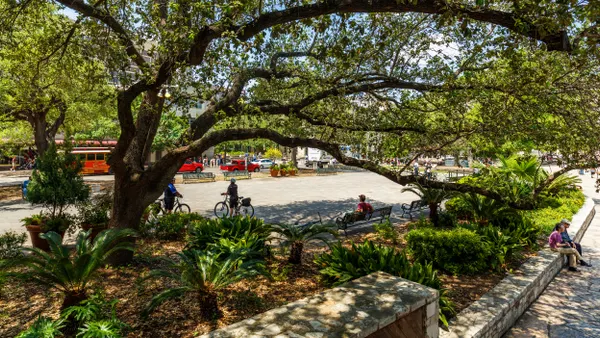Dive Brief:
- Pittsburgh's Department of Mobility and Infrastructure (DOMI) is launching the city's first pedestrian safety action plan, intended to provide policy and infrastructure improvements to support the city's five mobility goals.
- Those goals are that nobody dies or is seriously injured on city streets; everyone can access fresh fruit and vegetables within 20 minutes of home without a private vehicle; trips of less than one mile are easy and enjoyable by non-auto travel; no household must spend more than 45% of income on housing, transportation and energy; and streets reflect the city's values and pride.
- The plan contains 10 priority strategies and actions to improve pedestrian safety that the department will implement over the next few years. DOMI is required to measure and report on its implementation progress at least once a year.
Dive Insight:
"Pedestrians are the foundations of any city. Cities don't work if we don't have a high concentration of people on foot," said DOMI Director Karina Ricks during a webinar this week introducing the plan.
However, pedestrian deaths nationwide trended "in the wrong direction" during the pandemic, she mentioned. In fact, Governors Highway Safety Association data shows 2020 ushered in the largest year-on-year increase in pedestrian deaths nationally. Although fewer cars were on the road during the pandemic, most cities reported an "increase in poor motorist behavior" such as reckless driving and speeding, Ricks said. But the trend was evident even before the pandemic, with pedestrian deaths reaching their highest point in 30 years in 2019.
Speed often plays a large role in crashes, and this spring the World Resources Institute and World Bank Global Road Safety Facility published a low-speed zone guide to help global communities identify and implement speed mitigation measures to improve safety. A separate report also cited the risks of high vehicle speed and suggested the United States adopt a "Safe System" approach that centers on designing roads and traffic systems to reduce vehicle speeds and minimize crashes.
Pittsburgh's pedestrian safety plan compiles data showing crash trends throughout the city and hot spots where pedestrian crash risk is high. For example, it points out that the majority of crashes from 2013 to 2017 occurred on weekdays from 2 p.m. to 6 p.m.; severe injuries are more likely on high-speed roads with three or four lanes; 90% of crashes occurred within 500 feet of a transit stop; and 57% of fatal and severe pedestrian injuries involved a person 40 or older.
Throughout, the plan emphasizes the need for inclusive and equitable solutions. Ricks explained that pedestrians who are considered to be "vulnerable street users" are disproportionately represented in crashes and fatalities. These include older people, children and people of color. In fact, Black pedestrians in Pittsburgh are represented in crashes and fatalities 2-to-1 as a proportion of their place in the population, she said.
"This is why, if we're going to be an inclusive city, if we're going to be a safe city, if we're going to be a livable city ... we really need to enhance and improve all the pedestrian environments," Ricks said.
When pedestrians fear becoming involved in a crash because of poor driver behavior and infrastructure, walking or cycling is not enjoyable, and they are less likely to use those travel modes. That's why one of the plan's goals is to make improvements so short trips are enjoyable.
"Our goal is generally to always be creating equitable, accessible and sustainable infrastructure," said Cassandra Leopold, principal planner at DOMI, adding that the pedestrian plan should reflect those qualities because they contribute to a vibrant and dynamic city. "Although this is an action plan, we would love to see this transform into a pedestrian master plan."
Pittsburgh's push follows other efforts at the national and local levels. The U.S. Department of Transportation released its own pedestrian safety action plan last December. Portions of it help guide local governments in improving their pedestrian infrastructure. Members of Congress crafted federal Vision Zero legislation to make funding available for communities' efforts to bring traffic deaths to zero.
Like Pittsburgh, some cities devise dedicated pedestrian safety plans, while others incorporate that element into broader city plans. Milwaukee and Baltimore, for instance, are implementing complete streets policies that include pedestrian safety improvement elements.











